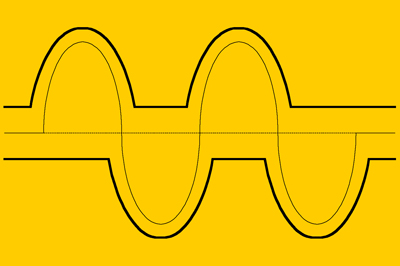Among lesser-known amplifier classes – yet viable and employed in pro audio applications – are Class-G and Class-H topologies.
Unlike some of the “hybrid” designs touted as “unique” topologies by some in the amplifier development community, these two designs are fairly distinct.
That said, there is some disagreement among the amplifier “experts” on the exact definitions of Class-G and Class-H. For purposes of general discussion, when more than one voltage rail is employed, or a pair of rails is used in the bipolar supply case, the unit fits a Class-G designation.
On the other hand, Class-H can be thought of as a more refined version of Class-G. Some claim if the transistors for each rail are connected in series, then it’s Class-G, and if the transistors for each rail are connected in parallel, it’s Class-H.
Yet some say that if the rail voltage is switched, it’s Class-G. If the rail voltage is modulated, it’s Class-H. (We’ll talk about moving rails a bit later.), However, when the transistors are in series, it can be said that the lower transistor is actually running from a modulated supply.
The two points of view presented here disagree, and there are others not included. And some even say Class-G and Class-H represent the same thing.
The general consensus is that Class-G runs from a low voltage rail until the signal goes beyond a certain voltage, and a higher rail (or rails) is switched in. Class-H refines this to use a variable higher voltage rail (or rails), also known as a modulated rail. Let’s simplify the matter and refer to both Class-G and Class-H as “multiple rail amplifiers.”
Both are actually forms of Class-A or Class-AB as used in audio applications: Class-G and Class-H require multiple rail voltages, and both are intended to improve upon the efficiency of Class-A or Class-AB. (Note that Class-A is impractical for this type of amplifier because we’re trying to improve efficiency.)
Multiple rail amplifiers usually allow significantly higher efficiency than single-rail Class-AB designs, and thus the interest in these sub-classes. The more rail levels are used, the higher the efficiency, assuming they’re spaced properly. While impossible in reality, efficiencies can reach 100 percent with an infinite number of voltage rails.
Multiple rail amplifiers typically use only two voltage rails, which amounts to more than 80 percent theoretical efficiency at maximum power. Using more rails becomes impractical due to added power supply complexity, but with four rail voltages, efficiency at maximum power can reach 90 percent (again, theoretically).






















